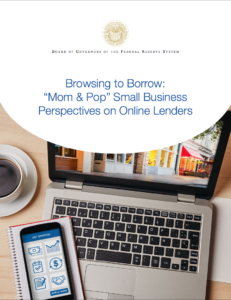 Browing to Borrow: “Mom & Pop” Small Business Perspectives on Online Lenders
Browing to Borrow: “Mom & Pop” Small Business Perspectives on Online Lenders
Board of Governors of the Federal Reserve System
First published June 2018
This report discusses findings of a study conducted by the Federal Reserve Board and the Federal Reserve Bank of Cleveland to gauge small business owners’ perceptions of online lenders and their understanding and interpretation of information online lenders use to describe their credit products. The Federal Reserve has an ongoing interest in small businesses and their access to the credit they need to succeed and grow. As the small business credit market evolves, prompting discussion about borrower protections, the perspectives of small business owners are an important consideration.
Nonbank, online lenders are becoming more mainstream alternative providers of financing to small businesses. These nonbank lenders offer small-dollar credit products including cash advances, lines of credit, and various types of loans, typically under $100,000. Borrowers can apply in minutes and receive funds in days or even hours, expedience made possible with data-driven technologies. The industry’s growing reach has the potential to expand access to credit for small firms, but also raises concerns about product costs and features, and the manner in which these are disclosed to prospective borrowers.
The study used online focus groups, a method of gathering participants’ perceptions through online discussions. The online format allowed for the collection of detailed responses, as well as insights into the complex decision processes of potential borrowers. As part of the study, participants evaluated sample loan products, presented in a format mimicking the language used and content provided by online lenders. They also visited the websites of actual online lenders and shared their impressions.
The participants recruited for the study operate small businesses (“Mom & Pops”) with at least one but no more than 20 employees, and less than $2 million in annual revenues, from a wide range of industries, located across the United States. Additionally, all participants had sought credit for their businesses in the prior 12 months. Two separate focus groups were conducted with a total of 42 small business participants. Given the relatively small sample size, this study was not designed to derive conclusions about a representative sample of borrowers; rather, the intent was to surface key issues that could guide future research, data collection, and policy analysis.
Download Resource